La relazione tra il livello di coinvolgimento nel processo di budget, il commitment verso gli obiettivi, la soddisfazione lavorativa e i relativi risvolti sulla performance manageriale. I risultati di un caso studio
Titolo Rivista MANAGEMENT CONTROL
Autori/Curatori Marco Giovanni Rizzo
Anno di pubblicazione 2014 Fascicolo 2014/1
Lingua Italiano Numero pagine 26 P. 9-34 Dimensione file 163 KB
DOI 10.3280/MACO2014-001002
Il DOI è il codice a barre della proprietà intellettuale: per saperne di più
clicca qui
Qui sotto puoi vedere in anteprima la prima pagina di questo articolo.
Se questo articolo ti interessa, lo puoi acquistare (e scaricare in formato pdf) seguendo le facili indicazioni per acquistare il download credit. Acquista Download Credits per scaricare questo Articolo in formato PDF

FrancoAngeli è membro della Publishers International Linking Association, Inc (PILA)associazione indipendente e non profit per facilitare (attraverso i servizi tecnologici implementati da CrossRef.org) l’accesso degli studiosi ai contenuti digitali nelle pubblicazioni professionali e scientifiche
- Soddisfazione lavorativa e work engagement nelle budgeting practices delle aziende sanitarie pubbliche. Una verifica empirica Domenico Raucci, Manuela Paolini, in MANAGEMENT CONTROL 1/2021 pp.13
DOI: 10.3280/MACO2021-001002 - Partecipazione al processo di budget, accuratezza e utilità delle informazioni di budget e performance. I risultati di un caso studi Gianluca D'Agostino, manuela S. Macinati, Marco G. Rizzo, in MECOSAN 92/2015 pp.55
DOI: 10.3280/MESA2014-092004 - Informazioni budgetarie e prospettive di Behavioral Management Accounting nelle aziende sanitarie pubbliche italiane Domenico Raucci, Manuela Paolini, in MANAGEMENT CONTROL 2/2022 pp.117
DOI: 10.3280/MACO2022-002006 - Sustainable Digital Transformation Domenico Raucci, Manuela Paolini, pp.95 (ISBN:978-3-031-15769-1)
- Towards Digital and Sustainable Organisations Manuela Paolini, Domenico Raucci, pp.69 (ISBN:978-3-031-52879-8)
- Orientamento al feedback, soddisfazione rispetto al feedback del sistema reporting e performance di budget Manuela S. Macinati, Marco Giovanni Rizzo, in MANAGEMENT CONTROL 3/2024 pp.179
DOI: 10.3280/MACO2024-003009
Marco Giovanni Rizzo, La relazione tra il livello di coinvolgimento nel processo di budget, il commitment verso gli obiettivi, la soddisfazione lavorativa e i relativi risvolti sulla performance manageriale. I risultati di un caso studio in "MANAGEMENT CONTROL" 1/2014, pp 9-34, DOI: 10.3280/MACO2014-001002